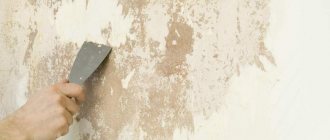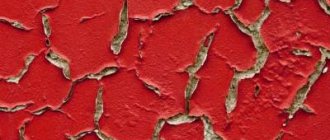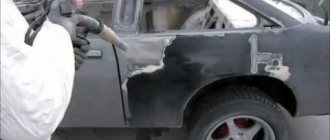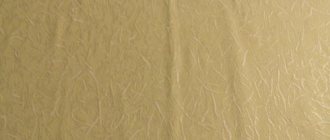Whether or not to remove old plaster from walls
Since the plaster layer for finishing finishing materials is most often the base layer, the strength of their fixation and durability depend on its condition. The application of plaster coating and its removal are associated with hard work, requiring a lot of costs, time, effort, and money. Therefore, when carrying out repairs, homeowners are interested in the question: whether to remove the plaster from the wall or leave it partially or completely.
Possible defects:
- cracks (can be treated without dismantling the coating, they are repaired, ground);
- rust stains (partial replacement of the solution or surface treatment is possible, removal of beacons and other sources of rust is necessary);
- plane fractures (additional leveling plastering without removing the mortar or complete dismantling and application of a leveling layer from scratch is possible);
- foci of biological damage (partial treatment of the area with a special agent is possible, but more often a complete replacement of the mortar mass is required);
- dutiki (removal of the entire cover);
- efflorescence (depending on the size of the area and the cause of its appearance, both partial and complete removal is possible, sometimes washing or treatment with special means is sufficient);
- peeling (removal of the cover, complete or partial);
- loss of strength by the material.
Most plaster defects are visible to the naked eye. The answer can be unequivocally when the old plaster coating falls off the walls and crumbles badly. These signs indicate that the plaster finish has lost its load-bearing properties. In most cases, the loss of load-bearing capacity is not so obvious.
Even the presence of cracks is not a reason to remove the layer, which can sometimes be strengthened or repaired locally.
Visually, the old coating may look reliable and intact. The condition of the layer can only be assessed by examining it. This is done by tapping. To do this, you can use a small hammer or other similar tool, as well as a spatula.
Nuances of the examination:
- They walk around the wall, tapping the surface with a hammer. The impacts should not be strong, but sufficient to assess the adhesion strength of the mortar thickness to the base.
- The layer that has moved away from the base has little strength and may fall off. In this case, only the upper near-surface layer or the entire coating layer may fall off.
- The detachment can be partial, and the plaster layer is held in place by adjacent layers that maintain strength; the defective area responds to the blow with a characteristic “hollow” sound. Therefore, you should listen carefully to the sound of the beats. If you are not going to “beat off” the exfoliated areas immediately, then their boundaries should be outlined with a pencil.
- In addition to peeling, loss of strength can be the result of poor-quality selection of the solution composition or a violation of plastering technology. In such cases, the material easily crumbles and crumbles, forming a depression at the site of the hammer impact. You can check for strength by running a corner or a spatula blade along the top with slight pressure. If the tool leaves behind a groove or sand grains peel off, the formation does not have the necessary strength.
- Where chipping is observed when using a spatula, it is necessary to find out how deep the area of loss of strength of the material extends. To determine this, the finish in the area with the groove is picked out with a spatula or screwdriver. Sometimes only the very top layer of the solution (2-3 mm) is weak. In this case, you do not have to remove the bulk, and the top can be secured using reinforcing agents. It depends on what the finishing will be (paint, wallpaper, ceramic tiles).
- It happens that the plaster coating crumbles right up to the wall. This means that all old solution should be removed.
- During the inspection, try to identify (so as not to damage during work) the places where the hidden wiring passes.
From the above, it is clear that the main reasons for which it is necessary to remove the plaster are peeling (low adhesion) and flowability (sandiness or low strength of the solution).
tapping plaster with a hammer
After determining the condition of the old solution, the issue of partial or complete removal is decided. In some cases, it is not necessary to dismantle the old coating.
For example, when finishing with plasterboard sheets, the plaster layer is not included in the work of bearing the weight of the plasterboard, then it can be left. In this case, it is necessary to transfer the load from the weight of the sheets directly to the wall material, which is achieved through the use of elongated self-tapping screws.
You can also avoid dismantling the mortar if the finish has a frame base. Mirror, wooden or plastic panels fixed to the frame do not put pressure on weak plaster layers.
Methods for cleaning walls from old plaster
Do I need to completely remove the old plaster or just the loose areas?
This question is often asked when performing finishing work in old houses. If you completely clean the wall for a new finish, the cost of finishing materials will increase significantly. At the same time, the repair time is also lengthened. Experienced builders recommend completely removing the old layer of wall covering. The reason is the “aging” process of the finishing material. Over time, the composition loses chemical strength, and the adhesion to the wall material weakens. New wallpaper pasted onto an unprepared surface may fly off after a short period of time, and the finishing putty applied to the previous layer may peel off.
Preparing the premises
When removing plaster from walls, dust and a lot of debris are generated. Falling pieces with sharp edges can damage parquet or linoleum. Dust has the ability to “eat into” everything, so it’s easier to prevent dust particles from getting on the surface than to remove it later.
Before removing plaster from the walls, you need to prepare the room:
- All the furniture is taken out of it. If heavy furniture is left, it is covered with fabric and film. But devices that are “sensitive” to dust, such as electronics, telephones or radios, simply need to be taken out of the room.
- The floors are covered with thick oilcloth so that its edges touch the walls. Matting, old paths or thick cardboard are often placed under the oilcloth so that falling pieces do not leave dents.
- All electrical wiring in the room is de-energized. Sockets and switches are protected by covering them with masking tape.
- Remove or protect lighting fixtures.
- Lay newspapers, old wallpaper or fabric on the window sills. Window blocks are also protected with film and tape. At the same time, the possibility of opening windows for ventilation is taken into account.
- If rooms are adjacent to the room, and the door blocks in the openings have not been removed, then the panels are wrapped with stretch film, and the trim is sealed with masking tape. The gap between the door and the floor is covered with an old rug to prevent dirt from getting into the adjacent room.
Preliminary preparation of the room is necessary even if it is planned to clean the walls from old plaster without dust, tapping it with a hammer. Behind the surface of the old plaster mass there may be hidden “surprises” that require the use of “dust generators”, for example, a drill or hammer drill. Before starting dismantling, it is advisable to provide for any surprises.
In what cases may such an operation be required?
When carrying out a major renovation, we evaluate the condition of the finish on the walls and make a decision on whether to preserve, repair, or remove it. If the layer of plaster is severely damaged, then sometimes the ideal solution is to break it completely, reaching the brick or concrete wall, since repairs will become too labor-intensive.
Sometimes, as part of a major renovation, we want to implement a radically different concept for decorating a room, and then the only option is to completely clean the walls, gaining access to them, then carry out insulation and finish everything again in accordance with the plan. For example, old plaster must be removed when installing heavy elements such as tiles and natural stone, since the base for them must be as strong and reliable as possible.
Important! Sometimes it may be necessary to remove not all the plaster, but to clear part of the wall from it. This happens when the wallpaper is unsuccessfully dismantled, the coating is otherwise damaged, or when greasy stains form that cannot be removed in any other way.
Preliminary processing
How quickly you can remove old plaster from a wall depends a lot on the pre-treatment. Gypsum and lime mass tend to absorb moisture and lose internal bonds. Old lime or gypsum materials saturated with moisture swell, after which they easily yield to the pressure of a spatula or scraper. To make it easier to remove old materials from the wall with your own hands, the surface is well saturated with hot water 15-20 minutes before dismantling begins. If necessary, the surface is wetted again during removal.
wetting the wall surface
On facades, you can use hot water from a hose. In rooms, water is applied with a sponge, rag or roller. If the layer of plaster to be removed is less than 6 mm thick, you can use a garden sprayer or spray bottle.
Another method of pre-treatment is the application of a special composition that softens the old material. As a result of its application and impregnation of the plaster mass, its adhesion to the base is disrupted and loosening occurs. To prepare, dilute 2 tbsp in a liter of water. spoons of starch (corn or potato). The resulting mixture is generously spread on the surface. Softening duration is approximately 10-15 minutes.
It may be necessary to remove the paint before removing the plaster compound. Water-based paint is “soaked” in water with iodine added to it. To remove water-dispersed enamel, special removers are used. Nabel is washed off with water.
Recommendations and tips
As with any other work process, removing old plaster from bases has its own subtleties, which will be useful to know in advance:
- To wet surfaces, it is better to use hot rather than cold water. This will allow the layers to swell as quickly as possible.
- Cleaning surfaces will be easier if you first divide the treatment area into even squares with a grinder or grinder. The squares should not be made too large - the smaller they are, the more you will weaken the strength of the old coating, which means it will be easier to remove it.
- Having finished processing the main surface, do not forget about the seams and joints. They also need to be cleaned of the old coating, otherwise the connection between the new coating and the finishing will be fragile. The seams need not only to be thoroughly cleaned, but also to be slightly widened – by about five to seven millimeters.
- After all the work is completed, the surfaces must be carefully processed and cleaned with a brush with metal bristles or a drill with a special attachment.
- The final stage: collecting debris and removing dust. It is extremely important to achieve ideal cleanliness of the surfaces, since the presence of dust on them will interfere with the quality adhesion of the new plaster and the base. Dust is removed from the walls by washing them with a brush, which is moistened in hot water.
The process of removing old plaster is a labor-intensive job that has its own specifics and requires compliance with a number of subtleties, so many people prefer not to do it themselves, but to invite specialists. If you still have questions about how to remove the plaster layer from surfaces, the detailed video instructions that complete and supplement the article will help you find the answer.
How to remove plaster from a wall
Of course, the most important question that worries beginners is how to clean the walls? To remove a lot of old plaster from the wall, different dismantling methods are used. This is done manually or using technical means, for example, power tools. Often the condition of the old coating and the varying accessibility of the areas to be cleaned require the use of different removal methods.
Manual removal falls into the realm of “silent procedures.” Such work does not require special skills, expensive tools, or energy costs. In addition, hand tools weigh little, working with them does not require large loads on the body. On the other hand, it may last longer. Another plus is the small amount of dust generated.
The sequence of cleaning the wall can be any. It is more rational to start cleaning from the bottom of the wall. Then the broken debris that falls off and accumulates on the floor is not an obstacle to cleaning the areas above. It is better not to accumulate garbage, but to regularly put it in bags and immediately remove it from the premises. Then you can place a chair or stepladder closer to the wall, from which you work.
To reduce dust formation, the wall is regularly wetted.
Methods for removing plaster using hand tools
Old plaster that has begun to peel off can be easily separated by tapping. First, the marked areas where the thickness has completely peeled off are painted out. Then the edges of the remaining thickness are pryed off with a spatula. You can increase the pressure on the cutting edge of the spatula by tapping its handle with a hammer. By driving the tool plate deeper, large layers can be removed.
Areas that are not amenable to the spatula are left and later removed by other means. For example, instead of a spatula, if the coating is sufficiently strong, use a chisel with a hammer. The chisel is placed close to the edge of the already cleaned area, holding it obliquely to the surface. To speed up the process, the wall is divided into sections, at the boundaries of which a groove is knocked out with a chisel. It is much easier to beat off fragments by placing the end of the chisel in a groove with an inclination of 45°.
A popular method, inherited from our grandfathers, is chopping with a hatchet. Chipping blows are applied near the edges at an angle. In this way, you can easily and, most importantly, quickly clean large areas.
A thin layer or partial remnants of the old mortar can be removed using sandpaper or a wire brush.
Where it is necessary to treat the base with care, a scraper is used.
Dismantling methods using power tools
Removal of plaster is also performed mechanically.
For this use:
- perforator;
- an electric drill with a chiselling mode;
- Bulgarian
The methods by which old plaster coating is removed are different for each tool. Mechanical removal produces a lot of dust, so it is advisable to use tools equipped with dust collectors.
Hammer drill
If the layers of old mortar being removed do not have high strength, they can be removed with an impact drill. Such a tool produces frequent blows of low power and low amplitude. The power of the drill can even be enough to break through a brick.
Using various attachments, you can either beat off the layered layers or cut them into fragments (with a disc abrasive attachment). You can also use a cup attachment with metal bristles. A drill with a brush is used for final stripping or removing a thin old layer.
angle grinder
People call this tool, an angle grinder, an angle grinder. To equip angle grinders, there are a number of attachments, including those that are used for removing plaster finishes. So, gypsum compounds are sanded off - removed with abrasive wheels or a brush attachment. They can also remove sandy, loose coatings.
For grinding, a grinding machine is used, the sole of which has rollers with teeth. When they rotate, only a small layer of old material is removed. You can use a scraper attachment for the same purpose.
More durable materials are cut into sections with a stone disc and then chipped off with a chisel.
When the removal thickness is more than 3 mm, a vibration grinding machine is used, the working part of which moves in a plane, moving from side to side.
Hammer
The fastest way to remove plaster from a wall is to use a hammer drill. For work, nozzles for hammer drills in the form of blades are used.
The hammer drill is set to chiselling mode. The spatula is placed at an angle of 80° to the surface and the plaster thickness is pierced to the base. Then the tool is tilted to 30-40 degrees and driven under the mass of material being removed. This method is recognized as the most effective for durable plaster compositions.
If the old plaster composition is too loose and sandy, this method loses its effectiveness.
Various attachments are used for removal. These are mainly chisel attachments with different widths, as well as chisel attachments, which can be curved. Many rotary hammers are equipped with dust removal attachments.
You can use a household hammer drill if the work is performed periodically, intermittently. To work in a more intense mode (5-6 hours with short periods of rest), a professional tool is used. In this case, the difference is in power, and not in the parameters of impact chiselling. A household instrument weighs less than a professional one - 3-5 kg, produces 1200-1500 blows per minute.
Working with a hammer drill when stripping brickwork is the most difficult thing. The blades periodically get caught in masonry joints. At the same time, the edges of the bricks break off.
Dismantling methods using power tools
Those areas that did not respond to the blows of hand tools will have to be removed using power tools. Be prepared for a lot of physical exertion and a lot of dust.
- The work will actually move faster if you use hammer drill with a nozzle in the form of blades of various thicknesses. It is necessary to work by switching the device to chiselling mode and setting it at an angle of about 80 degrees to the surface. In this position, it is necessary to punch through the plaster to the full depth, and then tilt the hammer drill at an angle of 30-40 degrees and begin to drive it under the mortar. This way you can achieve the greatest efficiency. But often a hammer drill is effective only when working with monolithic base surfaces, for example, concrete. As you pass through the softer layer of plaster, you will feel how the nozzle is already resting on hard concrete. Problems may occur when working to remove plaster from brickwork. Every now and then the nozzle can slip off the brick and get into the seam. Thus, not only the integrity of the connection will be compromised, but you may also end up with a lot of chipped bricks at the edges. Of course, if you are a professional, this may not be the case. In the case of removing loose plaster with a very high sand content, it may happen that the nozzle, penetrating deep into the composition, will simply make a hole, but not chip off. This is due to increased softness;
- In the same way, you can use a drill with a chiselling mode instead of a hammer drill;
- You can use a grinder with a disc designed for cutting the appropriate material. The old mortar is “cut” into pieces, and then chipped off with a hammer and chisel;
- By using grinder and with an attachment in the form of coarse sandpaper or a brush, you can sand off a layer of decorative gypsum plaster. It is necessary to determine the completion time of work visually - grind until the base material is exposed.
If it is possible to use a tool with a dust collector, be sure to take advantage of it. Maybe it makes sense to rent one for a few days.
Removing plaster from the ceiling
The most tedious part is cleaning the ceiling surface.
Work is carried out with hands raised up in uncomfortable conditions. It is impossible to say right away which method of cleaning the ceiling will be more effective. This depends on several factors. Most often, combined manual and mechanical dismantling is used.
Dismantling is made easier if you use a tool mounted on an extended handle and work from the floor.
After checking the condition of the old finish, cleaning begins using the simplest methods. Where this cannot be done, use an angle grinder or a hammer drill. To make work easier, the surface is prepared by soaking or softening with a starch solution. If the thickness of the finish is large, then, after removing the softened material, the surface is moistened or softened with the starch mixture again.
It is better to work not from a stepladder, but from a scaffold, placing a container on it for storing large pieces of garbage.
We work using an automatic tool
- Hammer. We switch the drill to impact mode and insert it into the thickness of the plaster at an angle of 80 degrees. Having reached the base, we shift the slope to 40 degrees, after which we move the tool to the side, destroying the plaster along the way;
- Bulgarian. The wall is divided into squares with sides of half a meter, along the perimeter of which grooves are cut. The latter will become the starting point for working with a hammer drill;
- Sander. On the surface of the tool there are rollers with spikes, which allows you to remove the plaster if its strength is relatively low. The advantage of this method is that it saves effort, but the disadvantage is a large amount of dust.
In general, the work about automatic means can be said that the grinder has relatively little efficiency in cutting plaster. Well, with a hammer drill, you need to take into account that during operation there is a lot of noise, and the duration of the process is very long, so the neighbors will have a hard time. Therefore, it is still better to try to get rid of it manually.
Important! We can radically reduce the amount of dust during work by pre-wetting the walls with water. Use this trick with any method of removing plaster, as it also softens the coating, making it easier to remove.
Complete dismantling or renovation?
The question: whether to remove plaster from a wall can only be decided taking into account individual conditions. Often complete dismantling is unnecessary, since the old finish can be repaired without “radical” stripping. For example, a weakened thin near-surface layer that stains your hands can be strengthened with adhesive-based impregnation. For this purpose, strengthening primers that penetrate deeply into the material are used.
Cracks are repaired with subsequent grinding. If it is necessary to repair only the top of the finish, making it suitable for wallpapering or applying paint, then after preliminary priming, a covering layer is applied to the surface. If only certain areas of the previous finish have become unusable, then cleaning is carried out locally. The cleaned areas are filled with the solution, applying it in layers.
It is necessary to completely clean the wall:
- When planning to make a suspended ceiling (an expensive coating can easily be torn through by a falling piece of exfoliated mortar). When cleaning, be sure to remove the thick layer of mortar covering the joint of the floor slabs. The joint is repaired with light adhesives using a reinforcing mesh.
- When it is necessary to finish a weaker old layer with materials that have greater strength and own weight, for example, cover a light gypsum composition with cement mortar. Such situations arise if the old material is applied unevenly, for example, with significant differences. (Even here there may be nuances).
- If you plan to cover the old plaster with heavy decorative elements, for example, tiles. Old material can withstand wallpaper, but cannot cope with the load (the weight of the tiles).
- If there is mold damage. This is another factor that requires radical repair. You will need to remove the plaster from the wall right down to the brick. Sometimes you also have to remove the top of the wall material if the mold has grown deeper.
- If leaks are identified that occur when using under-slaked lime. Ducts are formed not only on the surface, but also in the thickness of the solution. Therefore, if there are ducts, remove the lime composition to the base.
- When we deal with lime compounds. The weakened lime composition is completely removed. The same measures are used if they plan to apply cement-sand compositions over the old finish.
- When it is impossible to make a full strengthening. Sanded throughout its entire thickness, the cement mortar must be completely dismantled.
- If the stove or stone “clothing” is cracked or peeling. The presence of cracks and voids greatly reduces the thermal conductivity of the “fur coat”, so it is completely replaced.
- If the polymer composition is applied in violation of technology. As a rule, this type of compound is the most difficult to remove.
In other cases, it is more rational to perform partial repairs or local replacement.
Adviсe
- Never apply gypsum plaster over cement-sand mortar. The different composition of these materials causes a chemical reaction and their subsequent separation from each other.
- Before starting dusty work, cover furniture and other objects with cellophane film - you won’t have to clean them for a long time later.
- To quickly remove debris after dismantling the outer covering, lay a 1.5 meter wide cellophane film on the floor. After completion of work, the film is disposed of along with the garbage. We recommend that you periodically remove the generated waste into bags or bags.
- If you decide to carry out cosmetic repairs, it is not necessary to completely clean the wall of old plaster. It is necessary to leave areas that are difficult to clean. In place of the removed coating, you can safely apply a fresh composition of the same material.
- Crumbs from old gypsum plaster can be used to create walkways.
High-quality preparation of walls for finishing becomes the key to many years of operation of any room.
Personal protective equipment and safety precautions
Dismantling a plaster finish is always associated with flying small fragments of solid material, the formation of dust and the fall of sharp-angled pieces. Therefore, personal protective equipment must be used.
Required:
- Protecting your eyes not only from directly flying debris, but also from pieces flying in a ricochet, as well as from dust. The most practical and best protect the eyes are devices that fit tightly to the skin of the face. An unusual, but most effective means of protection is a diving mask.
- Using a respirator. Dust from old solutions is often not chemically inert, and clogging the bronchi with it is not the best result of repairs. The respirator protects not only the respiratory organs, but also part of the surface of the face. Unfortunately, when using an angle grinder and a hammer drill, a respirator may not be a “panacea”.
- Headdress.
- Clothing that covers the body as much as possible.
- Rigid shoes with high sides, into which the bottom of the trouser legs is tucked.
By observing TB, you will protect yourself from all kinds of injuries and preserve your health.
Savings associated with dismantling old finishes.
The cost of repairing the premises can be reduced if only exfoliated layers are removed. It is recommended to leave what is held very securely. This will make it possible to perform leveling with a smaller amount of solution.
It is rational, for example, to buy a more expensive mixture, but put it thinly. And “gain” the main thickness with the same composition with which the wall was previously coated. The cost of such repairs is minimal, although finishing is used with a high price per square meter.
If a situation arises in which it is more expedient to order the work from professional finishers, then preparing the work surface yourself can be a source of savings. After all, dismantling the plaster will increase the fee per square meter. m. since the team will have to do more work.
This is not advisable - preparing walls does not require special knowledge or experience. It is more economical to pay only what specialists charge per m2. skilled work.
Features of removing different types of mixtures from walls
When deciding how to remove plaster, take into account its material and how firmly it holds. Start with the use of hand tools.
The Venetian is removed by grinding or scraping. It is not recommended to knock it down due to the thinness of the coating.
Cement plaster
May make you sweat, especially if the material has good strength. The work is made easier by cutting the trim into 50x50 cm squares with a grinder. The mass of cement-sand mixture is cut to its full depth, after which it is easy to knock it down with a chisel.
Sanded cementitious materials are easily removed by scraping.
Gypsum plaster
The gypsum mixture is easier to remove than others. It sands off easily. Pre-soaking will be a good help. The effectiveness of soaking is higher if vinegar is added to the water. The same applies to lime materials.
What kind of plaster will you have to deal with?
The degree of complexity and other nuances of the work depend on what kind of composition was previously applied to the walls. At the moment, several options are most popular on the market:
- Cement plaster. It sits extremely firmly on the sides, and it is quite difficult to knock it down. Therefore, it is worth thinking about the feasibility of the work, looking for compromises - the ability to finish the room without the need to remove this layer:
- Lime composition. Over time, it may weaken and lose the ability to interact effectively with other types of finishes;
- Clay plaster. If it is necessary to carry out repeated plastering work, the clay layer must be completely dismantled, unless, of course, it is planned to apply exactly a similar option to it. All other types of plaster will be too durable for such a base;
- Polymer option. Due to their flexibility and durability, these types of finishes are highly durable and may not need to be removed frequently. The exception is the hasty initial finishing, when the building has shrunk and the material simply cracks;
- Gypsum plaster. The option of dismantling it may become relevant if it is necessary to carry out finishing work with something stronger and heavier than plaster.
In this case, it is easiest to remove clay, gypsum or lime compounds from the wall.
Features of removing plaster from different types of substrates
Structures can be made of various materials that have their own set of properties. Therefore, the removal of previous materials has nuances. Thus, removing plaster from a gypsum base can be done by sanding using power tools, while old material from a brick wall is removed mainly by hand. The latter is due to the fragility of old brick.
Features of dismantling plaster from drywall
Removing old plaster from a wall or from a plasterboard (gypsum board) partition is a task complicated by the fragility of the gypsum base. It is impossible to violate the integrity of the cardboard covering the gypsum board, since the cardboard jacket serves both as protection and as a frame for the core. Therefore, tapping with a hammer, using a chisel and power tools is prohibited. It is also not possible to diagnose peeling plaster on drywall by tapping.
To protect the gypsum board from destruction during the removal of the old finish, they act especially carefully. Using a screwdriver or knife, starting in one of the corners, pick out the overlying finishing layer to the cardboard. After exposing the cardboard shirt on a small patch, the rest of the work is done in cycles. The tip of the tool is carefully pushed under the finishing compound and the mass being removed is gradually picked out piece by piece. Sometimes a chisel is used, which is held to the wall at an acute angle.
How to clean plaster from a brick and concrete wall
Concrete bases are usually stronger than plaster. When working with a hammer drill or other tools, reaching the base is felt immediately. However, if notches are formed on the concrete itself as a result of cleaning, this may be to your advantage. In the future, notches on the concrete wall will help ensure the necessary adhesion with the newly laid mortar.
Cleaning bricks from plaster begins to be done manually, resorting to power tools in extreme cases. However, it is not enough to remove the plaster from the wall to the bricks. To apply the new composition, the top of the masonry joints must be freed from the mortar to a depth of 1 cm. This is a measure to increase the adhesion of the new plaster mass and the brickwork.
From a wooden wall
When applied to wooden surfaces, the finish is most often reinforced with shingles. It is with this that the nuances of cleaning wooden surfaces are associated. Wooden slats make it difficult to chip off the clay mass. Therefore, such surfaces are most often not cleaned, but covered with plasterboard. If cleaning is required, you will have to tap out the clay mass, and then tear off the mesh from the shingles using a crowbar.
Methods for removing plaster using hand tools
The room is ready, you are fully equipped, you can safely get down to business. The topic of how to remove old plaster from walls on many forums is called hackneyed and “worn to holes.” Indeed, nothing new has been invented yet, so we will try not only to list possible methods, but also to give some recommendations that we have collected based on user reviews.
- Layers of plaster, which have already begun to fall off in whole layers, are usually first tapped with a hammer, and then the edges are pryed off with using a spatula. Sometimes you can tap the handle of the spatula with a hammer to drive it deeper under the plaster and thereby chip off a larger layer. To facilitate the process and reduce the amount of dust, wet the surface periodically. If in some places fragments of the old coating cannot be touched by a spatula, leave them for later. Removing them will require other methods;
- Old plaster will fall off equally well from both concrete and brick bases. But what to do if it is put on drywall? Under no circumstances should the integrity of the sheet, much less its paper layer, be damaged. Therefore, it is impossible to strike with a hammer to destroy the plaster layer. It is almost impossible to tap a plasterboard wall, especially one that is hollow inside, to determine where the putty has already peeled off. Therefore, start from some corner, carefully pick out a small fragment with a knife or screwdriver. Now use the cycle. This tool resembles a spatula, only sharpened. With its help, you need to pick out the putty little by little, pushing it as carefully as possible under the solution. Sometimes you can use a chisel, but you need to hold it at an acute angle;
- If you need to make a big effort, use a chisel and a hammer. With its help you can remove the coating, which holds more or less firmly. To make the work easier and faster, divide the surface into small fragments. To do this, lean the chisel against the surface vertically at one angle and strike from above. You will tap the outline of the fragments in this way. Then tilt the tool at an angle of 45 degrees, placing it in the resulting groove, and start knocking, moving in one direction;
- The favorite “old-fashioned” method is to remove the mortar using a hatchet. In much the same way as notches are applied to a painted surface before tiling, it is necessary to apply oblique blows to the plaster. Many argue that this method allows you to get the job done fairly quickly.
All of the above methods are the quietest, the work is not accompanied by an enormous amount of dust and does not require special skills or the purchase of expensive tools. Plus, their implementation requires less physical effort. Is there a difference between wielding a small hammer or even a hatchet, or a four-kilogram hammer drill? The only drawback will be the low speed of work performed, of course, if the plaster does not fall off at the slightest touch. There are places where you can’t reach with a hammer, for example, in the corners, you will have to combine several methods.
On many resources you can find recommendations that it is best to start work at the top and work your way down. In fact, the following picture emerges: you tapped the corners, along the way, some layers of plaster fell off by themselves, began to move down, passed 2/3 of the wall and stopped. We stopped because a sufficient amount of construction debris had already accumulated on the floor, which simply did not allow us to reach the lower part of the wall. You will have to stop, shovel it to the side (or better yet, straight into a bag, so as not to do the same job twice), and only then continue. Therefore, it is better to start from the bottom of the wall. Even if you need to prop up a stool, the chipped fragments will not bother you. You will place it close to the wall, it will simply be inconvenient to work, since everything will fly into your face.
How to use leftover construction waste
Plaster compositions are a material that has a high weight. On average, 10-15 kg of garbage can be collected from a square wall with a layer thickness of 10 mm. And after cleaning even a small room there will be plenty of garbage. If renovations are carried out in a city apartment in a high-rise building, then all the garbage is removed and thrown away. You may need to call a car if throwing construction waste into containers is prohibited by local regulations.
Garbage is usually collected in bags without filling them to the top. A bag filled to the top will not be liftable. To make it easier to put garbage into a bag, a bucket without a bottom is inserted into the upper part of the bag. Then you won’t have to constantly pick up pieces that didn’t get inside due to the bending of the soft edges.
For those who are renovating a country house, waste can also serve as:
- Clay plaster is a material that can be reused. Pieces of clay are simply soaked and kneaded. Then mix without adding new components or with additives.
- Mineral plasters can be used as a filler for the foundation of non-load-bearing elements, for paving paths on the site, pouring the floor of a shed, etc.
- Gypsum waste can serve as an insulating bulk layer in dry outbuildings (ceiling backfill).
- Lime, as an antibacterial agent, can prevent plants from appearing where they are undesirable. For example, limestone debris can be buried in the ground under paths.
A quick repair is the dream of any home craftsman. We have provided you with information on how to remove plaster from a wall, in what ways it is easier and faster to do this.
How to order plaster dismantling in St. Petersburg
You can often see advertisements offering to remove plaster from walls, where the price for the work is stated to be ridiculously low. You shouldn’t get involved with such amateur teams; at best, after they leave, the apartment will turn into a dump; at worst, you’ll have to hire another team that will start working again.
Choose professionals. Our advantages: speed of work, quality, cost of removing plaster from walls. We offer professional dismantling of plaster, the price is indicated in the table, but not only. We remove waste from any floor and remove it using our own transport. Call, our operators are waiting for your applications.
Decorative plaster, depending on its relief and performance characteristics, has a certain service life. Therefore, after some time it will be necessary to eliminate its remnants. There are several ways to remove the finish.
Preparatory activities
Removing plaster is a dusty operation; performing even a small amount of work will greatly pollute the room, so it is better to completely vacate the room, which is what is done in most cases.
Then they examine the condition of the plaster coating - tap the walls with a hammer. In places where the plaster has peeled off, the wall will “bounce” under impacts - such areas are approximately outlined with chalk along the contour. If the “bumping” surfaces do not exceed 30% of the total area, then it is advisable to limit ourselves to spot repairs of the coating - replacing defective areas. In case of delaminations of more than 30% of the area, the decision on the scope of repair is made based on a combination of the following factors:
- Strength of plaster in remaining areas;
- Material of execution and thickness of the old layer;
- Availability of reinforcement;
- Base material (concrete, brick, presence of shingles).
The final decision is made after analyzing the current situation, but the behavior of old plaster, good today, is still unpredictable in the future, so ideally it is better to replace the defective coating completely.
If replacement of communications and internal power supply systems in the apartment are not planned, then on the walls before removing the plaster it is necessary to mark the location of existing pipelines and electrical wiring - this will reduce the risk of damage during work.
Lighting fixtures, sensors, sockets, and switches are dismantled in the room. The ends of the wires released from the contacts are insulated.
In bathrooms, sinks are removed, toilets are covered with knocked together protective boxes, and bathtubs are covered with thick felt.
If the floor finish must be preserved, it also needs to be protected - with hard flooring (plywood, chipboard, fiberboard, boards).
The next stage is preparing the tool. Depending on the situation, devices from the following list are used to remove plaster:
- Extension cord for connecting power tools;
- Hammer drill with pobedit drills and chisel attachments of various widths;
- Grinder with attachments - a “dry cutter” disc, cleaning cups, a grinding wheel;
- Grinding and stripping machine – for dismantling thin-layer coatings;
- Half sledgehammer or hammer with hand chisels;
- Hard spatulas;
- Carpenter's scraper - for removing gypsum plaster from hard-to-reach surface areas;
- Scraper - for cleaning the seams of brickwork.
Work on removing old plaster must be carried out using PPE (personal protective equipment):
- Respirator;
- Safety glasses – especially important when dismantling tile flooring; helmet;
- Safety shoes – protection of feet from falling debris;
- Workwear;
- Gloves.
Where should I put the garbage?
Disposal of old plaster remains is important. It is not always possible and time to remove it, which is due to the range of special landfills and the work of public utilities. In apartment buildings, removal is possible only by special transport. In private homes, the problem is easier to solve: waste can be reused. Cement-sand screed is used as a material for pouring paths, a filler in concrete mixtures for forming platforms and paths. Clay plaster is saved for reuse. There is no need to mix the solution, since the proportion of sand and clay has already been measured, the materials are thoroughly mixed, it is enough to saturate them with moisture. Remains of gypsum plaster are used as insulation for the construction of floors of utility buildings.
Permanent address of the article











